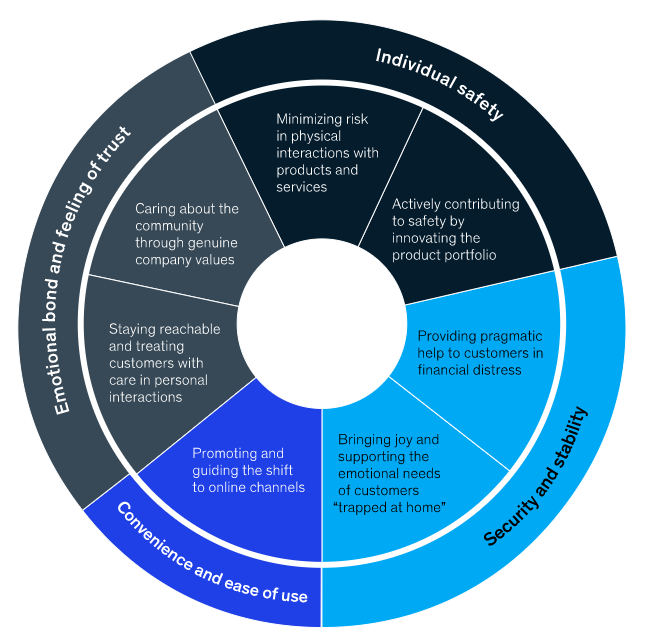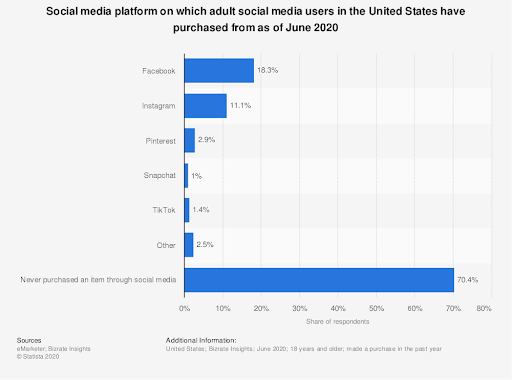
Think back to the tail-end of 2019. You’d probably just finished framing your marketing plan for the new year. Everything thought down to the last detail. Production orders given out. You looked to the time ahead with hope and excitement.
Only, no one could’ve possibly predicted how quickly all that effort would’ve been rendered useless. Indeed, 2020 will always be a stark reminder of just how unpredictable mother nature really is.
And, nowhere was the impact more visible than on social media. Feeds were flooded with news, messages of concern, and questions about the future. People began spending longer hours on their chosen platforms doom scrolling, or looking at disheartening headlines became a thing.
All of this obviously had massive repercussions for social media marketing. Just how do brands communicate with their customers and audience in times of uncertainty?
Here are 10 ways in which 2020 changed social media marketing.
Engagement took center stage
Social media marketing was always more about engagement than the sale. But, this point became even more important during 2020.
A Mckinsey survey of US consumers found that 39% respondents couldn’t pay bills after one month of unemployment. Trying to sell during such a time is just a bad idea.
Instead, this was the time for brands to step up engagement with their customers. Mckinsey recommends seven ways in which brands can do so —

The overbearing emphasis here is on empathy. Reminding people to follow safety protocols, offering them free help and just being there for them.
The key question here was how could a brand stay relevant? Not every product was important or even needed, after all.
This is why brands needed to hone their keyword research skills. They really needed to drill down to the core of their audience’s issues and find out what was bothering them.
But, more importantly, they needed to discover ways to solve their issues using their product/service.
Everyone was forced to go back to the basics
With no one buying and marketing budgets gone, marketers had to fall back to the most fundamental of methods. Essentially, marketers could no longer avoid the question — does my audience even want to hear from me?
During the pre-COVID era, marketers went with a “throw wet paper towels at the wall and see what sticks” strategy. Let’s face it. This is just soft-spamming an audience.
Every marketer must ask themselves just how relevant their messages are, instead of bombarding subscribers. Basically, brands had to ensure their messages were truly relevant.
A “less is more” approach became the norm as posts had more thought and helpful intent behind them.
Likewise, marketers were also confronted with the uncertainty of spending money on advertising. CPCs soared, but there was no guarantee they would yield any results.
Consequently, personalized, one-on-one interactions became more important. The popularity of tools like the LinkedIn email finder rose exponentially as marketers wanted an affordable way to find accurate information on their target audience.
[code_snippet id=6]
Influencers became even more important
Influencers present unbiased information on trends, products and services which is why one in three consumers trust them over a brand. Their views became all the more desired during the pandemic as they shared valuable information with their fan base.
Working with influencers became a no-brainer for companies in 2020. This was partly because their in house content production had come to a stand-still. But, more importantly, because of the trust that influencers command.
That being said, influencer marketing can be a bit tricky. You can’t really hire them to promote your brand. Remember, people trust them because their opinions are unfiltered. Instead, your product or service should genuinely deliver on its promises.
While you can go for the biggest influencers out there, don’t forget the smaller ones. Often their fans are more dedicated and engaged.
Not to mention, you can spread your budget over several influencers for greater traction. For example, True Blue Life Insurance partnered with vloggers, bloggers and social media personalities during 2020 with great results.
Likewise, brands like Gilisports had partnered with Instagram influencers through 2020.
They had several sweepstakes, where they gave away paddle boards to people who followed them online.
Videos were the most popular content medium
The importance of video as a marketing tool has been on the rise. But, it took a whole new meaning during 2020. Video consumption increased 11% for baby boomers, 35% for Gen X and 44% for Gen Z.
These numbers are hardly surprising. Videos are more engaging, informative and the viewer needn’t exert any effort to watch them either.
Consequently, video is now the “new normal enabler” as it allows brands to create connections when direct interactions weren’t possible.
Even so, the changing realities meant marketers had to adapt their video strategies.
Slashed budgets meant production costs were lower. This meant less Hollywood like video quality and more “from the sofa broadcasts.” While this may seem like taking a step backwards, the authentic, homely feel such videos brought were largely welcome by people.
The great thing about video is that it works pretty well for all kinds of businesses, including B2B. For example, the company LFA Capsule Fillers used it’s video channel to explain how its product works.
Brand awareness took precedence over sales
Social media was always a place for brands to build their image and stay in touch with their audiences. But, over the years, many companies have started to treat it as a regular sales channel.
It was common to find social media feeds filled with links to landing pages and soft-sells posing as concern. 2020 shattered this trend.
The prospects of an uncertain future and collapsed supply chains caused people to become more frugal. They bought things they genuinely needed.
For example, 44% of respondents to a survey said the Coronavirus pandemic impacted their purchasing decision.
The new reality meant brand awareness and equity became all the more important. Companies had to stay relevant, else their audience would forget them.
Different brands tried different strategies throughout 2020. For example, this company selling sunglasses for runners continued to post photos its clients had shared on social media.
Content marketing importance cemented further
More people were spending more time indoors, and had more time to spare in 2020. Consequently, the global online content consumption increased significantly.
The trend wasn’t across the board though. Only content from news, pharma, healthcare, media and food industries saw a massive increase in viewership. Other industries saw their audience decline.
While many took this as a sign to give up on social media marketing and wait the crisis out, others stepped up their game. Content marketing worked in such times because it prioritized experiences.
Again, the need of the hour wasn’t sales-driven content. Rather, it was empathetic, educational and entertaining pieces that helped and shared without asking anything in return.
Relevant content allows brands to stay relevant, regardless of whichever industry they’re in. So long as their content helps, they’ll continue to generate interest. This was true before COVID, but became more so after it.
The most significant types of content included user-generated, visual, video, podcasts and webinars. Again, all of these content formats were gaining traction long before COVID came along. We can expect their popularity to rise in the coming years.
Social commerce climbed up a few notches
Even though sales fell in 2020, the inertia behind social commerce caused it to continue rising. Social commerce is simply selling things through social media.
It was gaining momentum because of its simplicity. Most social media marketing funnels look like social media post -> landing pages -> email list -> blog post -> landing page -> sale.
But, often many of the steps between the post and sale are irrelevant. So long as the product genuinely solves people’s problems, it won’t need much marketing legwork.
Social commerce is far more streamlined and presents fewer steps to a shopper. They see something useful/likeable, they buy it, that’s it. And, given that most people were spending a lot of time on social media, social commerce was bound to see an uptick.
While COVID certainly affected many industries adversely, social commerce wasn’t one of them. Social commerce is expected to grow at a Compound Annual Growth Rate (CAGR) of 31%, up to a whopping USD 2051 billion by 2024.
This is primarily due to social media platforms introducing new shopping features. Instagram, for instance, introduced their Shops feature. Shops is an immersive, full-store experience that allows people to purchase items straight through a story or post.
More companies used live streaming
Watching pre-recorded videos is great, but experiencing the same thing live is another feeling altogether. Facebook, Instagram and Twitch all have live streaming features that allow content creators to share live stories with their fans.
Why does this matter? Live streaming works because it’s kind of like watching a very interactive, organic webinar. The audience knows the content creator’s views are unfiltered.
Brands can also respond to their follower’s questions or views in real time. It also offered people a coping mechanism to get past the loss of regular in-person communication.
It was no wonder then that Facebook alone saw a 50% increase in live stories video consumption in the first quarter of 2020. Similarly, Instagram Live stories saw a 70% jump during March 2020.
The tool offered a ready made solution for brands trying to communicate with an audience in lockdown. Brands could get really creative here, too. Live streams on everything from recipes and workout routines to fixing pipes became common.
Live is nothing new though. In fact, it’s just the latest iteration of ye’ old conference call. If you remember using Skype, Google Hangouts, or Zoom, then you’re already familiar with Facebook Live too.
Regulatory control tightened
Social media began as a benign, fun way for people to connect and get to know each other. But, almost 3.6 billion people are sharing a lot of (very) private information on it today.
The various sites also collect even deeper insights on its users, which give them immense power. Power without much regulatory supervision.
It was then hardly surprising when scandals like the Cambridge Analytica erupted. Facebook was found selling user information for political advertising without their consent. This meant entire national elections were open to manipulation by the highest bidder.
Movies like the Social Dilemma and Max Schrems’ campaign against Facebook also brought the dangers of social media to the public’s attention. Consequently, the EU began working on the Digital Services Act (DSA) to make sure such happenings stayed in the past.
But, what does this mean for regular companies trying to stay in touch with their customers? Firstly, since people’s faith in the platform is shaken, they might think the same about the companies they do business with.
Is my data safe? The landing page says X company won’t share my details, but how do I know? Your audience is bound to ask such questions and possibly more.
Content marketing can help you out here. Regularly publishing content on how you keep your user’s data safe will be a good start. You can also educate your audience on how they can safely share their information without putting themselves in harm’s way.
Conclusion
In many ways, 2020 was the start of a new era in social media marketing. It constricted choices across the board. As a result, marketers had to do more with less. The ones that rose to the challenge ended with strategies that will pay back several times over when marketing budgets return to normal.
It was also a stark reminder of the sheer uncertainty we face. No matter how fool-proof your plans may seem, it’s always a good idea to entertain what-if scenarios.
Interested In Working Together?
Introducing Delivered Social. We’re The Most-Rated Digital Agency In Surrey & Hampshire – We’ve Got To Be Doing Something Right.
Delivered Social is a digital marketing agency with one mission—to help businesses grow. We’re famous in Guildford and Portsmouth for our social clinics. We believe in free advice. We build lasting relationships because our team prides itself on being helpful, which our clients appreciate.
If you are looking for a new website or an agency to manage your social media presence, we can help.
If you need something slightly different, here's a super handy list of all our services, or you can always email us.






















